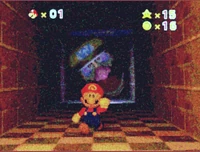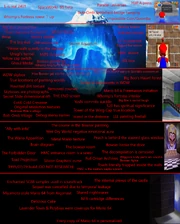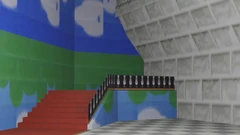The common explanation for the different experiences and occurrences people have with Super Mario 64 is the belief that every copy of Super Mario 64 is personalised. It changes and adapts to the player in different ways to adhere to their desires, playstyle and skill. This is done through an experimental personalisation artificial intelligence which seems to pull assets from the game and modify them to the player's needs.
The personalisation of a player's copy of Super Mario 64 can be noticed easily by playing another person's copy of Super Mario 64. Many players have noted how strange or unfamiliar another person's copy of Super Mario 64 can be. This is most noticeable with the most commonly circulated ROM of Super Mario 64 on the internet. This ROM is only contains some of the surface level changes that the game has to offer, and is the same ROM used in the Virtual Console releases of the game.
The concept of personalisation has blown up on the internet due to the many bizarre anomalies it spurs, with the most strangest and expansive being documented by many.
Capabilities
The A.I. should only capable of pulling assets from Super Mario 64, unable to create assets of its own. This can include bringing back assets that are functional yet go unused, such as Blargg or the Dancing Flower effect. A prime example of this and one that spurred alot of the conversation about personalisation is the 1-up hidden in Whomp's Fortress. Many recall there being a visible indicator, such as a cracked wall texture, to show the player that the 1-up is there. Alas, in the prime circulated ROM there is no indicator leaving many to not know of the obscure secret.
The A.I. can also change assets of levels. This falls under the concept of Dynamic Level Rearrangement, where the A.I. will change elements of the level to reflect a change in theming or difficulty. At its most simple, it'll merely change and modify textures and object placement. At its most complex however, it can change the very missions that the player must go through, or even change the arrangement of instruments in the music to create whole new tracks.

The Wario Apparition chasing Mario, showing both the beta HUD and Wario Apparition, both things sourced from earlier builds of the game.
Strangely, the A.I. appears to be able to pull from beta content too. Most instances of the A.I.'s happenings usually features some version of the original beta heads-up display that was shown within the game's promotional material, even though very little of this original font exists within the retail release of the game. Perhaps the most popular anomaly, Wario Apparition, is theorised to source from the remnants of a beta build of Super Mario 64 where Wario appeared.
The A.I. seems to make its predictions based off the player's playstyle, not the player's subconscious like many assume. Despite this, the A.I. is highly complex and it has an eerie level of accuracy in predicting the player's wants and needs. While the A.I. could not reasonably learn a player's name, it could certainly learn a lot about them by the way they play Super Mario 64.
Anomalies

The original Super Mario 64 iceberg.
- See also: Iceberg
Some of the most rogue changes from the A.I. can be described as anomalous and are cataloged on the infamous iceberg image that has been floating around on the internet. Not everything on the iceberg is necessarily an anomaly; its purpose is to document some of the strange phenomena revolving around Super Mario 64, and that can include glitches and strange bits of lore. However, certain entries on the iceberg can be explained by the A.I.'s adaptation of the game, or can be related to the A.I.'s inclusion in the game.
Existence
The existence of the Personalisation A.I. is debatable due to the lack of evidence behind it. Originally, the idea that every copy is personalised was used an explanation as to why some people have varying memories of different encounters in Super Mario 64, with nothing to back it up aside from people's anecdotes. This reasoning is in a similar vein to the Mandela Effect, where people remember events differently and explain it with the existence of alternate universes that people unknowingly travel between.
Alternatively, some people interpret that the Personalisation A.I. is real and has to do with the development of Super Mario 64. The most common belief is that the Personalisation A.I. was an experimental A.I. revolving adaptation that was sold off to Nintendo in early 1995. The experimental and advanced nature of the algorithm supports this, as it appears to be outside of Nintendo's scope of expertise. This A.I. was tested and tried in the 1995/07/29 build, but when playtesters reported unexplainable differences and disturbing imagery Nintendo would go onto deny the existence of the A.I. for years onward. While Nintendo couldn't remove the A.I. from the game, they tried to cover it up by silently distributing a minimally personalised ROM up onto the internet, along with using that ROM for future rereleases on Virtual Console. These claims do have some validity, as during an interview with Shigeru Miyamoto, he stated "The game always changes with players playing." While this may be a mistranslation on his part, while attempting to communicate something completely different, the interview does in some regard match up to the idea of a Personalization A.I., changing the game in subtle ways as the player plays.
The publicly released Oman Archive, which released with heaps of information about the Nintendo 64 and helped with early Nintendo 64 emulation, is said to be censored and only a fraction of a much larger file. What that larger file contains is unknown, but many presume it to be remnants of the Personalisation A.I.. Later on, the iQue leaks of July 25th, 2020 had only a partial reserve of what this beta build of Super Mario 64 had to offer. This leads some to believe that the Personalisation A.I. was excluded from this leak as well. At the same time, the reverse-engineered PC port made by fans also seems to lack any trace of the A.I.. With all of these cases in mind, it can be inferred that Nintendo are silently pulling the strings behind the scenes by silencing or hiding the Personalisation A.I. from public sight, or it's just unfortunate happenstance that all of these efforts seem to just lack any trace of the A.I..
Documentation
Many users online have come forth supposedly documenting their findings relating to the Personalisation A.I.. For example, Youtuber jefftastic documents his playthrough of two Super Mario 64 cartridges in a video series, where he comes across bizarre sightings such as the White-eyed Chomp or the Aquarium Limbo. Meanwhile Youtuber Greenio unearths tapes of various origins showing the types of phenomena that the A.I. unearths from within the game.
Manifestation
While the very code that make up the Personalisation A.I. cannot be found within the game, many theorise that the A.I. has to exist within the game in some form or capacity.

An image commonly associated with the Internal Plexus theory. A room of Princess Peach's Castle with broken textures, where the exterior wall of the castle has clipped through the room, creating unsettling imagery for some.
The most common belief is that the A.I. assembles itself with the structure of Princess Peach's Castle. This theory, commonly known as the Internal Plexus, states that the strange arrangement of rooms in the castle is a representation for the artificial nervous system that makes up the personalisation algorithms. If arranged in the same map, many rooms would overlap each other and jut out of the castle[1]. The explanation for this is that the A.I. has grown larger than the castle exterior shell shows, and this is further emphasised with the existence of secret areas within the castle that are exclusive to some copies, such as the fourth floor.
A possible yet highly debated manifestation of the A.I. retains to a leaked entry array supposedly found in Super Mario 64, where the A.I. can manifest itself as a non-playable character to assist the player in their adventure. While this array has yet to be found in any of the known decompilations of Super Mario 64, a handful of players have recounted seeing characters that match up with the names found within the array.
Theorising
Benevolent A.I. Theory
While many consider the A.I. to be an insidious abomination of human creation, it's also possible that the personalisation algorithms were made to ensure that Super Mario 64 was a fun and memorable game that changed every time one played it. It is possible that manifestations of more anomalous phenomena are a misguided attempt to create new experiences for every playthrough. This would be in line with Nintendo's business model of trying to create games that are fun and replayable.
Intentional Manipulation Theory
A theory presented by Youtuber SwankyBox, there's a potential likelihood that some personalisation done to Super Mario 64 could be intentional or accidental tampering and damage to the cartridge, only for it to be sold on or rented out by a different person. This different person would go on to play this altered game, only to experience the bizarre and unordinary. The idea of damaging a cartridge would make sense, and can be done manually with cartridge tilting. However, this theory fails to explain the deliberate changes that could be done to a Super Mario 64 cartridge, such as added levels or the existence of the more extreme anomalies. Although, the early hacking scene could easily have created simpler phenomena like the White-eyed Chomp or soft Dynamic Level Rearrangement.
Gap Filler Theory
Proof of the existence of the A.I. has managed to evade the public for years, leading many to believe that the Personalisation A.I. doesn't exist at all. Instead, many perceive the Personalisation A.I. to merely be an excuse or rationalisation for poor memory retaining to their experiences of playing Super Mario 64. Many people who claim to have seen these instances of "personalisation" recall them from their childhood, a time where the brain is developing and memory can prove faulty. Memories also have the tendency to be muddled up with other memories, hence why some people can remember Super Mario 64 having features of other games or even its DS remake. Human memory is fallible, and it's common for people to try and rationalise this disconnection with the past with outlandish theories, such as with the Mandela Effect[2]. Coupled with Nintendo denying the existence of the A.I. and the lack of evidence for it, it's conclusively possible that the Personalisation A.I. is merely the result of collectively misconstruing memories.
Trivia
- In the community, the Personalisation A.I. was depicted as a textureless yellow Mario with pale skin, called Stanley. The name is taken from the array of names that the A.I. can personify as, and also has origins with Stanley the Bugman from Donkey Kong 3.
